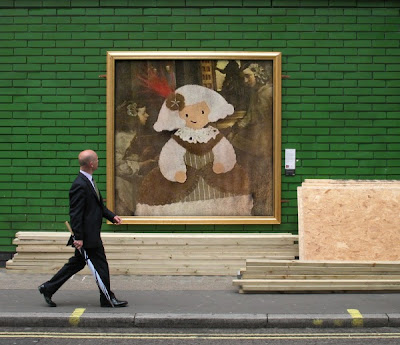El tema del cuadro parece trivial, la infanta y sus damitas de compañía (meninas en portugués) irrumpen en el estudio de Velázquez, pintor de cámara del rey Felipe IV, que se encuentra pensativo y observa los modelos que se dispone a pintar. Nosotros podemos ser esos modelos ya que somos contemplados por Velázquez. Sin embargo, los reyes Felipe IV y Mariana de Austria, a quienes vemos reflejados en el espejo del fondo, son las personas que el pintor retrata.
Técnicamente el cuadro es insuperable. El conjunto de perspectivas utilizadas es único y produce un efecto "atmosférico" en el ambiente representado, como si el pintor hubiese pintado el aire entre las figuras. Vamos a analizarlo: la primera perspectiva que observas es la lineal, diversas líneas imaginarias o no (línea del techo-pared; cuadros colgados, el suelo) guían nuestra vista hacia el fondo y nos hacen creer en una fuerte tridimensionalidad. Este asombroso efecto se refuerza con un suelo neutro, de moqueta, que avanza hacia nuestra posición y, sobre todo, con unos espacios alternativamente iluminados y en penumbra que subrayan el efecto de alejamiento. La otra perspectiva es la aérea, la difuminación progresiva de los contornos y la degradación de las gamas tonales con el aumento de la distancia y el alejamiento. Como remate, Velázquez pone un agujero iluminado en el centro (la puerta abierta) que da a una estancia donde no vemos el fin, es decir, el cuadro tiene una perspectiva ilimitada.
Esta combinación de perspectiva aérea y lineal es lo que ha fascinado a todos, expertos o no, desde el siglo XVII. (Fuente: www.cossio.net)
Visitad mi tienda en Etsy: latelierdeluluu.etsy.com
Disfrutadla!!!
***
About this work of art people have said more laudatory adjectives. Luca Giordano, a painter of Charles II, called it the 'theology of painting' to gather in one fell swoop all the possible virtues in the pictorial art. Carl Justi said ‘here is one picture that makes us forget it’. O Teophìle Gautier, that when saw it, was so amazed by the naturalness and realism of what is represented that cried exclaimed: ‘But ... Where is the box?’
It is simply one of the peaks of universal painting, well imitated and admired later by all. Velázquez painted it in the 1656.
The theme of the picture seems trivial, the Infanta and her little company ladies (meninas in Portuguese) burst into the study of Velázquez, painter to King Philip’s camera, which is thoughtful and notes that the models are available to paint. We may be those models because Velázquez covers us. However, the Kings Philip IV and Mariana of Austria, whom we see reflected in the mirror at the back of the room, are the people who portrays the painter.
Technically the picture is unbeatable. The whole perspective is used and produces a unique ‘atmosphere’ in the environment represented as if the painter had painted the air between the figures. Let’s dissect: the first perspective is to look at is the linear range, imaginary lines or not (line of the roof-wall, hanging pictures, floor) guiding light to the bottom and make us believe in a strong three-dimensionality. This amazing effect is reinforced with a neutral floor, carpet, moving towards our position and, above all, with some spaces alternately illuminated and in darkness to highlight the effect of remoteness. The other perspective is the air, the gradual blurring of the contours and the degradation of the tonal ranges with increasing distance and remoteness. At this end, Velázquez puts a hole in the centre illuminated (the open door) that provide a stay which end we do not see, i.e., the table has an unlimited prospect.
This combination of linear and aerial perspective is what has fascinated everyone, expert or not, since the seventeenth century. (Source: www.cossio.net)
Visit my Etsy store: latelierdeluluu.etsy.com
Enjoy!












No hay comentarios:
Publicar un comentario